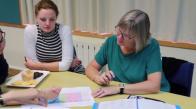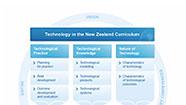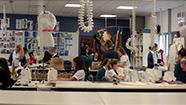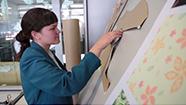Massey University students worked with high school students in a client-designer relationship.
Koha and collaboration in textiles
Transcript
Sandy Heffernan: We introduced the koha project last year to allow collaboration and to encourage the students to gather different perspectives on design so that they would listen and hear the views and opinions of others.
The values and attitudes of koha that we were hoping to implement were that of koha is a gift, reciprocity, and exchange. So we thought that it was an ideal opportunity to work with the secondary schools, and so that our students could share their knowledge and they could gain insights from the secondary students.
Kristy Johnstone: So I work at Massey as one of the tutors. For the koha brief the students were asked to create a "thneed". So the brief was based on this idea from Dr Seuss’s The Lorax where there were thneeds, which were “fine somethings that everyone needs”. So the students from Massey were to go and interview students at Wellington Girls' College and St Catherine's College and find out if they could make something that would meet their need.
The Massey students had been learning dye techniques and they were to incorporate that into their final thneed design. The students were to take a human-centred design approach where they were to hear, then create, and then deliver.
The Massey students showed the school students some of the things that they’d been doing in design. So they took along their knit samples, some of the colour work that they’d been doing, and their dye processes and techniques. They were able to share with the students and then show them this is what we’ve been doing over the past six weeks and we want you guys to help us identify some ideas to take forward and develop into a thneed.
So from that first initial meeting the students from Massey then created some concepts and ideas of thneeds that they could make for the specific high-school students and asked the high-school students for feedback. So this was done through various means of communication. The main one was Pinterest. Others chose to use email or facebook, or snapchat as well. So on their final hand-in day they presented their final thneed, along with the board showing what it should be used for. And then the high-school students were invited back into the textile department so that they could see what our students had created. The outcomes of the thneeds included a scarf-hood-pocket-wrap combo so it was kind of several things in one and the student dyed her own yarns using the colour palette agreed on with the high-school student. And then she then knitted that. The idea was that the students thneed was she could wear this on the way to school when she was standing at the bus stop all cold.
So I think this project was beneficial for both the Massey students and the high-school students taking part in it. The Massey students were able to engage in this really beneficial relationship with the high-school students, kind of treating it as a client-designer relationship.
Student one: The advantages of this project was working with a client to get an outside perspective of someone else’s opinions, rather than just within the university.
Student two: And it was really enjoyable working with someone who had a similar aesthetic style as I do, which was the case with my client. Like we both really liked the same things.
Kristy Johnstone: It gave the high-school students as well a chance to come into Massey and actually see the design process taking place at the tertiary level. And also the stuff that they were learning in school about concept and design development that still applied once they’d left high school.
Student three: I found it really interesting to see the design process at Massey and how comparing it to what we do.
Student four: It was really interesting to see the tertiary style and mixing with the secondary style.
Student five: I found it really interesting like seeing the different work spaces between what the Massey students work in and what we work in at school.
Kristy Johnstone: They had a look around the department and they were able to see a lot of the different processes that we do here, from screen print to dye, through to knit and weave. And they were able to engage with the students further as well as see what actually goes on at the university.
Related videos
School-wide programme planning (04:18)
Cheryl Pym explains how collaboration forms the foundation for school-wide planning in technology education.
Reviewing programme planning in years 7–13 (03:23)
At Diocesan School planning focuses on technology components for years 7–10, and establishing scholarship potential in year 13....
Review of curriculum implementation (03:49)
Margaret van Meeuwen explains how a cycle of self-review has enhanced delivery of curriculum.
A technology department with a digital and design focus (04:13)
Julie Clement shares how a design focus has engaged her students.
Resourcing for a digital and design focus (03:18)
Julie Clement considers how resources influence the authentic experiences for her students.





